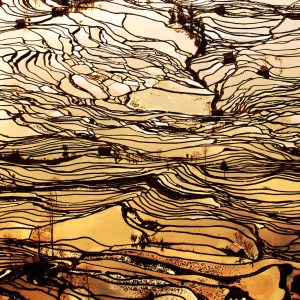
Terraced rice fields in southwest China's Yunnan province (Imaginechina via AP Images)
Ugh. Hong Kong’s English daily South China Morning Post has a distinctly unsavory dispatch from the Chinese media this morning: Government scientists have released research that millions of acres of Chinese agricultural land and over 12 million tons of Chinese grain are contaminated by toxic metal pollution, according to this week’s edition of the China Economic Weekly, a state-run magazine.
Last week, a separate article reported that 10% of Chinese rice contained excess cadmium, a heavy metal known to cause cancer.
Beijing quickly responded to last week’s news by announcing it was re-focusing its efforts to reign in heavy metal pollution over the weekend, identifying 4500 operations across the nation, including chemical manufacturers, battery manufacturers and mines, to be put under stricter controls. Today’s SCMP article says the farmland pollution is particularly bad in China’s southwestern Yunnan, Guangdong and Guangxi provinces.
The polluting effects of China’s rapid industrialization are hardly news. But the industrial clusters cropping up in the nation’s farm belts present new problems. Food safety in China in the past few years has primarily been framed as a problem of corruption in the supply chain, as was the case in the melamine scandal, or the overuse of pesticides, insecticides and chemical fertilizers in agriculture. Crop contamination by heavy metals from nearby industry that soak into the soil did not start this year — in fact the rice samples used to determine the 10% contamination rate were taken back in 2007 — but the scope of the problem is just beginning to be fully comprehended.
The domestic health ramifications of this information will take even longer to determine. China’s has a growing list of what have come to be known as “cancer villages” — towns next door to badly regulated factories where myriad forms of pollution have caused high cancer rates in residents. In January, to name one example, a battery factory was forced to close after more than 200 children living in its vicinity were diagnosed with high levels of lead in their blood in Anhui province, just west of Shanghai. (Read about how your jeans might be contributing to China’s industrial health problems.)
So what happens when this kind of contamination is spread to millions of Chinese consumers, albeit at lower levels? (China exports relatively little rice; the U.S., for instance, only imported about $4 million in rice from China in 2010, compared to $13 million in soybeans.) Rice, China’s staple food, turns out to be a particularly good conduit for the metal cadmium, particularly hybrid rice varieties that are planted in acidic soils, as is widely the case in southwest China. And cadmium is not the kind of thing you want to be ingesting in vast quantities. OSHA describes it as an “extremely toxic metal” with the following effects from acute and chronic exposure:
- Acute — Indicates that metal fume fever may result from acute exposure with flu-like symptoms of weakness, fever, headache, chills, sweating and muscular pain. Acute pulmonary edema usually develops within 24 hours and reaches a maximum by three days. If death from asphyxia does not occur, symptoms may resolve within a week.
- Chronic — Identifies the most serious consequence of chronic cadmium poisoning is cancer (lung and prostate). The first observed chronic effect is generally kidney damage, manifested by excretion of excessive (low molecular weight) protein in the urine. Cadmium also is believed to cause pulmonary emphysema and bone disease (osteomalcia and osteoporosis). The latter has been observed in Japan (“itai-itai” disease) where residents were exposed to cadmium in rice crops irrigated with cadmium-contaminated water. Cadmium may also cause anemia, teeth discoloration (Cd forms CdS) and loss of smell (anosmia).
The China Economic Weekly report estimates economic losses from contaminated rice could be as much as $3 billion a year. But that’s making a big assumption — that the metal-laced rice gets pulled out of the supply chain and counted as a loss. It’s highly unlikely that millions of tons of rice in China are going to go through the kind of highly standardized testing this would require. The long-term costs of dealing with large swaths of the Chinese population that slowly ingest cadmium with potential effects ranging from kidney damage to bone disease are, to put it lightly, harder to calculate.


